Guinea pigs are small animals that are increasingly finding their place in homes. Affectionate, they will make your children happy. However, in order for them to flourish at their best, it is necessary to take care of your pets by meeting their needs perfectly. The health of your pet depends on vitamins and a specific diet.

Follow our advice to ensure that your guinea pig receives an adequate daily intake of vitamins and stays healthy.
Why should I give my guinea pig vitamin C?
Just like humans, guinea pigs do not synthesize vitamin C (also called ascorbic acid). Due to an old genetic mutation, our favorite little pets can no longer make vitamin C from glucose. The intake of vitamin C in their diet becomes a necessity.

Vitamin C is a molecule that slows down the aging of cells, helps prevent the risk of infections and accelerates healing, therefore, vitamin C intake should not be taken lightly since deficiencies can cause serious health problems in your pet.
The signs of vitamin C deficiency are plentiful and here is what should alert you:
- Your guinea pig is losing weight, does not want to eat or eats differently
- For young guinea pigs, growth inefficiency may be visible
- Your guinea pig’s immune system slows down which can cause many infections. There are also problems with the joints and difficulties for moving. It is important that you are alert to any lesions or sores that may have difficulty healing. If your guinea pig squeals when you pick him up, that’s not a good sign.
Should I give my baby guinea pig vitamin C?
The answer is yes. It is recommended that you give your guinea pig the vitamin from an early age so that it does not suffer from deficiencies.
In addition to vitamin C, which we will focus on in the rest of our article, your guinea pig also needs its dose of vitamin E. Much less mentioned than the previous one, vitamin E is also necessary for maintaining the good health of your pet. If your guinea pig is deficient in vitamin E it may be suffering from muscle problems and this may also be the cause of high mortality in female guinea pigs. This vitamin participates in the production of cells, it therefore has an essential role.
A little tip for vitamin E: Between 3 and 5g of vitamin E should be contained in 100g of food.
Foods rich in vitamin E: Fennel, broccoli, tomatoes, spinach, peppers and oatmeal.
What foods naturally contain vitamin C?
Many fruits and vegetables contain vitamin C. These foods are easily found in the supermarket. It’s even better if they come from your small vegetable garden! Always wash vegetables and fruit before feeding them to your guinea pig. It is important to present them to your pet as a treat, he will appreciate it more. Do not hesitate to vary his diet by offering different vegetables according to the seasons.
Key figures: The daily intake of vitamin C in guinea pigs should be 20 mg / lb. of body weight for an adult guinea pig. This dose can rise to 60 mg / lb. of body weight for a growing guinea pig, a pregnant female or a sick guinea pig. If you want personalized advice for your guinea pig, do not hesitate to ask your vet.

Image by Viola ‘ from Pixabay
Foods rich in Vitamin C suitable for guinea pigs in 150 g portions (be aware, it is not a question of giving 150g of the same vegetable but of varying the plate):
- Horseradish:contains 141 mg.
- Parsley: contains 140 mg.
- Kale: contains 120mg. Be careful, this food should be eaten in moderation since it may cause bloating in your animal, just like other types of cabbage (Brussels sprouts, cauliflower, white cabbage, red cabbage, green cabbage, etc.)
- Fennel: contains 120 mg.
- Red Pepper: contains 126 mg. Red peppers contain more vitamin C than green peppers.
- Broccoli: contains 93 mg.
- Dandelion: contains 58 mg.
- Chicory: contains 24 mg.
- Radishes: contains 23 mg.
- Tomatoes: contains 19 mg. In addition to providing vitamin C, they are rich in water.
- Zucchini: contains 10 mg.
- Celery: contains 7 mg.
- Cucumbers: contains 5 mg.
This list is not exhaustive, but gives you an overview of foo-
ds rich in vitamin C which you might already have at home! We advise you to vary your intake and ask your vet for more information.
Small dietary reminder: Do not feed guinea pigs rhubarb, onions, leeks, chives, garlic, avocado and lettuce (rich in nitrate) and avoid carrots as they are often too sweet.
We often forget it, but grass is also a source of food for guinea pigs as it is a complete food. You can also supplement the diet with leaves of strawberries, raspberries (beware of thorns), mulberries, willows…
Fruits must also be integrated into their diet, but be careful as they are highly concentrated in sugar and should be given in moderation.
Sometimes, despite a varied and balanced diet, vegetables and other plants are not enough. Guinea pig owners are therefore advised to provide them with vitamin C supplements.
How to give vitamins to my guinea pig? In what form should they be favored?
Vitamin C is available in a variety of forms so you should be able to find something to suit your guinea pig’s preferences. Just like humans, some will prefer capsules while others prefer a liquid form.
Liquid form: Ask your vet for advice on the brand you should choose. The vitamin is injected with a syringe. This method is complex because you have to succeed in getting your guinea pig to ingest the desired dose by placing the syringe in the side of the mouth. Avoid putting it face-on or pushing it into his mouth, he could choke. Do not put vitamin C in liquid form in water. Vitamin C is sensitive to light and air, and could break down very quickly. Protect the bottle from light and recap the bottle quickly after use.
Capsules / tablets: This is an effective way to make sure that your guinea pig is getting its daily amount of vitamin C. There are brands on the market that allow you to get the optimal dose. If your guinea pig has difficulty swallowing the tablet. You can hide it in a banana for example, or in other fruits that your guinea pig enjoys.
Powdered: This form of vitamin C should be taken with caution. The powdered sachet, once opened, must be quickly consumed by the guinea pig or the benefits may be lost. Powder on contact with air will simply lose its effectiveness. The powder has a positive though; you can put it on a piece of cucumber or another treat that your pet loves, the vitamin will then be easily ingested.
Vitamins C and E should be supplied throughout the life of your guinea pig. However, avoid overdosing. Indeed, too much vitamin C can also be dangerous for your animal and cause urinary stones. Check with your veterinarian for the exact dose of vitamin C to give your guinea pig, to help him/her stay in great shape to live life happily and healthy.
This entry was posted in Guinea Pigs
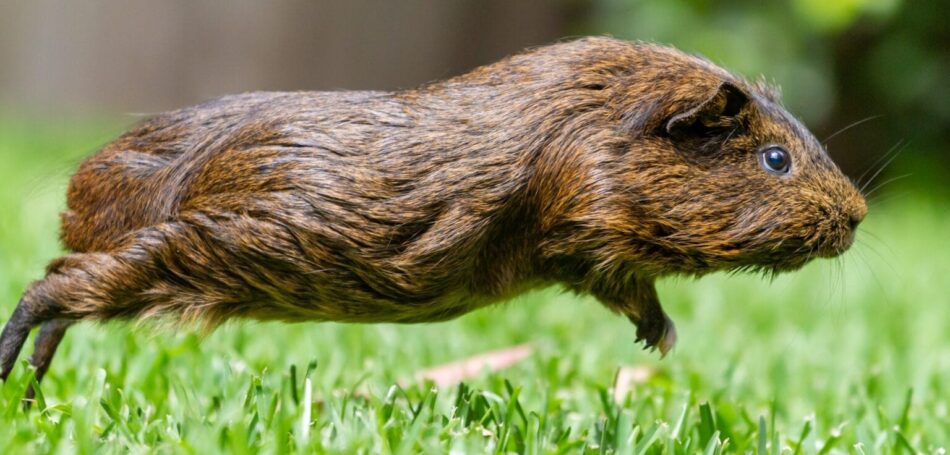 What is popcorning in guinea pigs?
What is popcorning in guinea pigs?
When a guinea pig is happy and excited, it will often ‘popcorn’. This describes the sudden jumps performed by guinea pigs, sometimes from a standing position, sometimes in mid-stride, and often involving a change in direction and an endearing squeak! But why do guinea pigs popcorn?
What does it mean when guinea pigs popcorn?
Guinea pigs, being naturally portly, need all the exercise they can get in order to stay trim. It is thought that when guinea pigs popcorn it is part of their natural workout. You can find out more about guinea pigs and their exercise requirements in our How Much Exercise Do My Guinea Pigs Need? blog. It may also be a behavior that causes predators to stop in their tracks, out of sheer surprise, giving the guinea pig an increased chance of escaping unscathed.
Not all guinea pigs entertain their owners with popcorning, but most of them do. The usual reason why guinea pigs popcorn is happiness. They’re simply having a good time, they become excited, and pop! They are literally jumping for joy. Well, most of the time…
Do guinea pigs popcorn when scared?
Popcorning in guinea pigs is certainly not abnormal, although guinea pigs may occasionally popcorn out of fear. You can easily tell when this is the case – was there a sudden noise, for example, or did the guinea pig spot a cat or dog or some other potential danger? If fear is the trigger, the guinea pig will run for cover after landing, and will often make some alarm calls too.
In most cases, however, a guinea pig will ‘freeze’ rather than popcorn if it perceives danger. This is a behavior common to all rodents (and rabbits too). Read more about rabbit behavior in the Learn to Read your Rabbit’s Body Language from Omlet.
Popcorning can be seen in many young mammals (although it is only called popcorning if a guinea pig is involved). Young lambs are a classic example. The behavior is often part of a running and jumping combination, actions known to guinea pig lovers as zoomies.
Encouraging a guinea pig to popcorn
Although guinea pig popcorning can’t be taught to a guinea pig as such, your pet can be encouraged in various ways. Offering a favorite treat often inspires the behavior, and in a keen guinea pig pop-corner, the very sight of the treat might, in time, produce the behavior. At this point, it crosses over into training territory, and if you use a command word (such as ‘popcorn!’) each time a treat is offered, you are in with a chance of making your pet associate the word with the treat. This means, in theory, that simply saying ‘popcorn!’ will cause the guinea pig to jump for joy!
Guinea pigs love exploring new toys, and these will often produce a spell of guinea pig popcorning, too. The excitement often lasts, too, and a new hay station, ball, ramp or section of a guinea pig tunnel will often produce a popcorn jump several weeks after the item was first introduced.
Regular play sessions with your guinea pig will be a source of pleasure for your pet, too. If they feel safe with you in their run, guinea pigs will sometimes popcorn their way into double figures. If you pick them up, and cuddle them, it will often inspire popcorning when the guinea pigs are back on the ground.
If you have a secure space outside the guinea pig cage, this can provide great stimulation for inquisitive guinea pigs. Supervise your furry friends as they nose through the space, and count how many times they perform a popcorn! This should only be allowed outdoors if the space is completely secure and safe for guinea pigs (i.e. no gaps in the fence, no other pets, no toxic plants), and if the outdoor temperature is warm (a minimum of 64 F).
Why do guinea pigs do ‘zoomies’?
It’s a little odd that the guinea pig, a short-legged animal that lacks the ability to climb very well and is usually unable to jump over an obstacle, should be able to perform these vertical take-off maneuvers. Younger guinea pigs tend to jump highest, and more portly specimens will seldom attempt to perform zoomies and popcorns. Younger guinea pigs, in general, will do most of the running and jumping, letting off all the excess energy associated with youth and vigor!
Novice guinea pig keepers have been known to mistake guinea pig popcorning for a seizure. Once you take time to watch your guinea pig you will soon spot the difference, however, as the guinea pig popcorning will become a very familiar sight, and there is no confusing the two. A guinea pig that is having a seizure will fall on its side and wave its legs around, often with jerky motions to the head. The attack will last several seconds too, unlike a swift popcorn. If, after jumping or falling, a guinea pig fails to get back to its feet immediately, it’s time to consult the vet.
Guinea pig popcorning and guinea pig zoomies are two of the things that make guinea pig keeping such great fun. These little furry characters are so full of fun, it’s contagious!
Whilst guinea pigs do a pretty good job entertaining us with popcorning, make sure that they have everything they need to stay amused with Omlet’s range of guinea pig products. From the Zippi Guinea Pig Tunnel System to the Caddi Guinea Pig Treat Holder, your furry friend will absolutely love these awesome accessories!
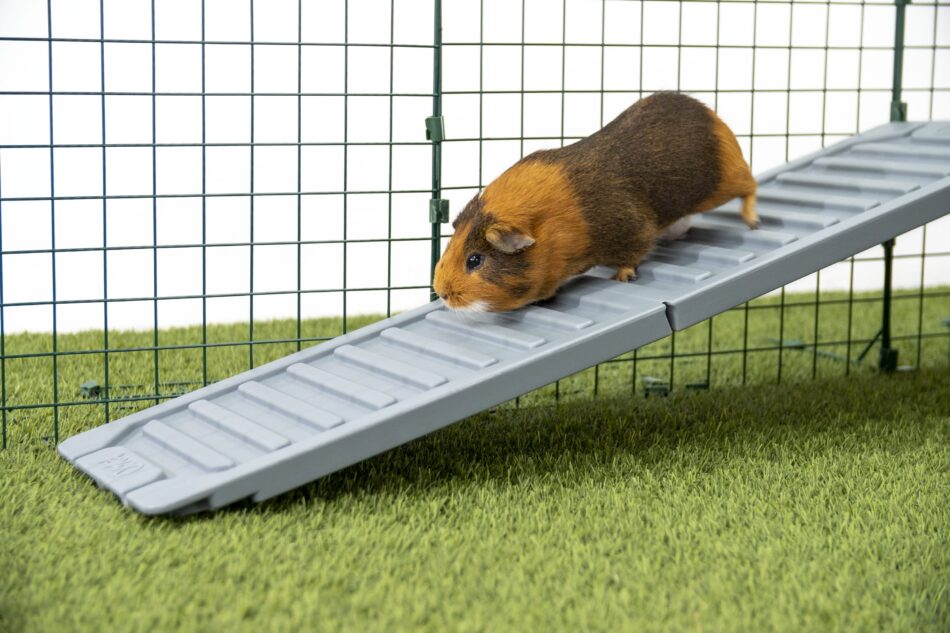
While guinea pigs do a pretty good job entertaining us with popcorning, make sure that they have everything they need to stay amused with Omlet’s range of guinea pig products. From the Zippi Guinea Pig Tunnel System to the Caddi Guinea Pig Treat Holder, your furry friend will absolutely love these awesome accessories!
This entry was posted in Guinea Pigs
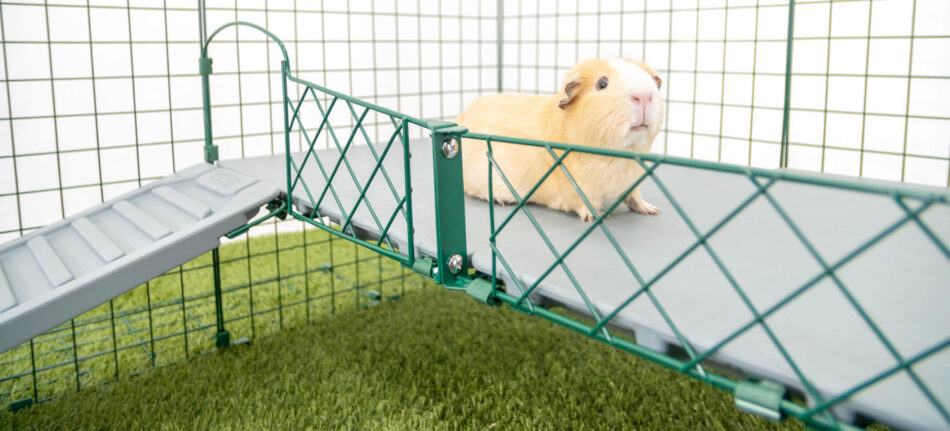
Guinea pigs, AKA Cavia porcellus originate from the South American Andes, where they lived amongst the varying terrains of the mountains. Foraging comes naturally to this species as their ancestors spent their days exploring the rocky landscapes and grasslands to find their next source of food. And whilst these pets are not built for marathons, what they do need is a combination of hutch and run along with extra tunnels and accessories to provide them with plenty of exercise space and mental stimulation. Omlet’s guinea pig products have been expertly designed to encourage this instinct, ensuring that today’s household cavies get the exercise they need.
How do guinea pigs exercise?
Whilst small mammals of the rodent families may all look adorable, fluffy and vaguely similar, hamsters and guinea pigs do not have the same needs. Therefore, hamster-style wheels and balls are not required (and can, in fact, be very dangerous for guinea pigs). You can discover more about this topic in our What’s The Difference Between a Hamster and a Guinea Pig? blog. Instead, you should make sure that the floor area of your guinea pigs’ hutch is a minimum of 0.75 square meters for hutches containing two cavies.
The floor area is where they’ll spend much of their time, so the bigger the living quarters, the better. The indoor part of a hutch is only half the story, though, and guinea pigs need some outdoor space, too. It is recommended that they should have at least three hours each day exploring, filled with plenty of exciting exercise, where they can run, skip, and popcorn! This is easy to arrange if you combine a hutch and run, and an all-in-one living space such as The Eglu Go Hutch for Guinea Pigs is the ideal option.
Guinea pig runs can also be linked to outdoor playpens using an arrangement such as the Zippi Guinea Pig Tunnel System. Whilst guinea pigs no longer have to search amongst the terrains of the Andes for food, this kind of flexible system allows you to construct anything from a simple A to B tunnel, to a full-blown maze with a delicious vegetable hunt, allowing them to practise this behavior. Did you know that a guinea pig’s sense of smell is actually 25x better than humans?! Therefore, a tasty vegetable hunt using your Zippi Tunnel System, Zippi Shelter, and Guinea Pig Tunnels, is the perfect setup for physically and mentally stimulating your cavies!
For a pair of Guinea pigs, a one- to two-metre-square run provides ample space. If you can to give the pets more space than this, they will only really use it fully if it has plenty of tunnels and bolt holes to head for – guinea pigs don’t like to be too far away from somewhere safe and cosy, and will not usually roam in a large garden.
How do you exercise a guinea pig? – encouraging your cavy
Guinea pigs are more inclined to run around and have fun if they have companions to play with. So, rule number one for ensuring that your pets get enough exercise is to provide them with at least one playmate. In the wild, extended family groups could be at least10, but you should always keep the numbers to a level dictated by the size of the hutch and run. You need to get the mix right, as a male and a female will inevitably mate, which has obvious consequences in terms of space and mouths to feed.
Groups of males or groups of females are the best option. A castrated male will mix very happily and placidly with females, and any small disagreement and scuffles among your guinea pigs is unlikely to result in injury and is all part of their exercise routine.
Incorporating hiding places in your run/hutch/tunnel set up is an important detail. Guinea pigs instinctively have one eye on a safe bolt-hole when they are out and about, and scurrying back to safety is probably their most strenuous form of exercise.
You can encourage your pets to scout around and stretch their legs by putting interesting objects in their run, such as a Caddi Treat Holder, wicker toys stuffed with guinea pig treats, chews, tunnels and simple hideaways in the form of terracotta caves and igloos. They will also play happily with the cardboard tubes from the inside of loo-rolls and paper towels, or a simple cardboard box, especially if these items are stuffed with hay and fresh veggie treats.
One of the things that gives guinea pigs such a unique character is their loveable combination of endless inquisitiveness and nervousness. They follow their noses, explore everything, and then dash back to safety, making those wonderful wheep wheep sounds as they do so. With this mixture of playing and bolting, their exercise needs are easily met – all you need to do is provide the hardware.
Guinea pig exercise is all about exploring and interacting. They are very sociable animals, moving around their enclosure in groups or dashing away on little adventures of their own. You can find everything you need for your fluffy friends on the Omlet Guinea Pig shop and for even more ideas on guinea pig exercise why not take a read of our Guinea Pig Activities blog?
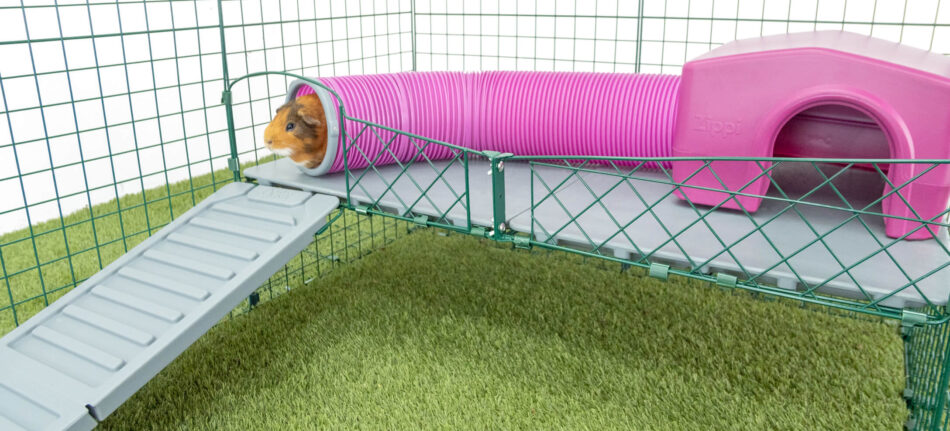
This entry was posted in Guinea Pigs
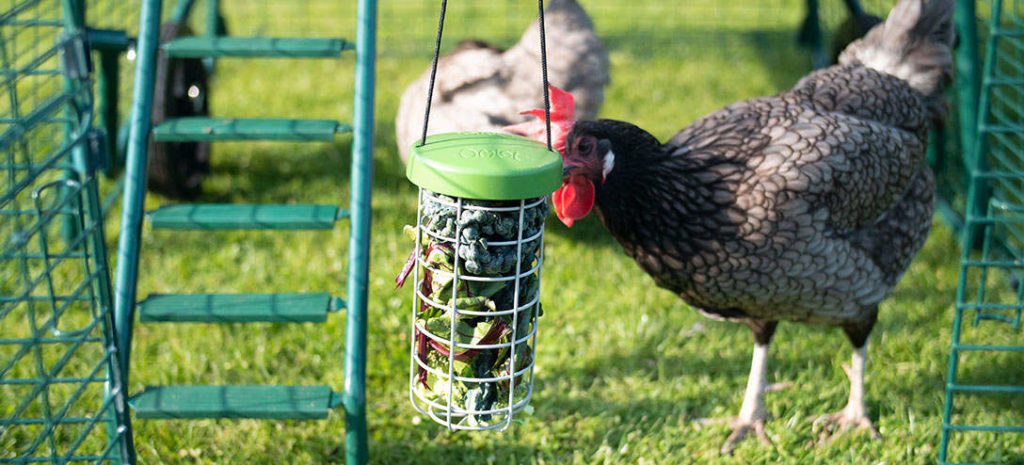
Here’s why the Caddi is the perfect choice for your treat-loving pets…
- The Caddi Treat Holder decreases the rate at which your pets will eat their treats. Slower treat release through the gaps in the holder means more satisfaction for longer, and prevents over indulgence.
- The Caddi Treat Holder swings around and creates a rewarding, interactive game to keep your pets entertained, which is especially great for rainy days! Your pets will love the stimulating experience of foraging for their treats, and enjoy hours of rewarding fun.
- The Caddi allows you to feed your pets treats without having to throw them on the ground. This improves run cleanliness, reduces food waste and prevents pests, as well as being a healthier solution for your pets. Simply hang the Caddi from the roof of your pet’s run with the plastic hook and use the string to adjust the height to suit your pets.
- Endless treat opportunities! With the Caddi Treat Holder you can feed a range of fresh greens, fruits and vegetables to your pets, you can use it as a hay rack for rabbits, or fill it with pecker balls for hens. Get creative and reward your pets with exciting new flavours in the Caddi.
- You can save 50% on the Caddi Treat Holder until midnight on Monday, just by signing up to the Omlet newsletter. It’s a great deal for you, and an exciting new treat dispenser for your pets! Enter your email address on the Caddi page to claim your discount code.
Now available for just $6.49 if you sign up to the Omlet newsletter! – PROMO NOW ENDED

Terms and conditions
This promotion is only valid from 08/12/20 – midnight on 08/17/20. Once you have entered your email address on the website you will receive a unique discount code that can be used at checkout. By entering your email you agree to receive the Omlet Newsletter. You can unsubscribe at any point. This offer is available on single Caddi Treat Holders only. The offer does not apply to Twin Packs or bundles with Omlet Peck Toys or Feldy Chicken Pecker Balls. Offer is limited to 2 Caddi Treat Holders per household. Subject to availability. Omlet Inc. reserves the right to withdraw the offer at any point. Offer cannot be used on delivery, existing discounts or in conjunction with any other offer.
This entry was posted in Chickens
Guinea pigs have many little ways of showing how much they love you. They may not be as obvious as dogs or cats in this respect, but once you know the signs they’re actually quite easy to read.
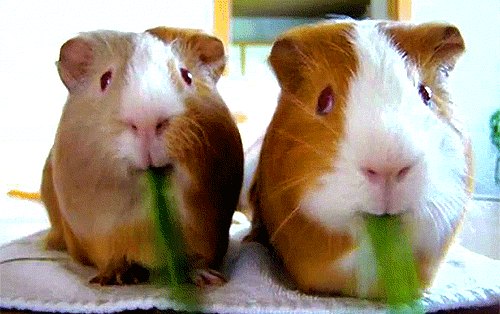
Your Guinea Pig Likes Being Held
GPs are timid creatures by nature, so it takes a lot of confidence for them to come to you for stroking or holding. You can interpret that confidence as affection. To reach this stage you need to hand-tame your pet with care and patience. Once they’ve built the trust, they’ll bond with you. They won’t approach everyone in this way – it’s just you they love!

Your Guinea Pig Likes Being Hand-Fed
It will take a little while to reach this stage. Rather than holding a tasty treat in your hand and hoping for the best, it’s best to train the guinea pig in stages. Leave a little trail of treats, and call to your pet gently. Eventually they’ll make it to your hand, and once they’ve become accustomed to this contact, the special bond between pet and owner will be complete.

Your Guinea Pig Follows You Around
By nature, a guinea pig wants to hide from humans, freeze on the spot or run away. It’s a sign of affection when they become so comfortable with you that they happily follow you around. Even if there’s no treat waiting for them, at this stage in the relationship they’ll stay with you simply because they like you and you make them feel safe.

Your Guinea Pig Doesn’t Bite!
This may sound like an odd demonstration of love, but it’s actually a sign that your pet feels very comfortable in your presence. If the GP is in any way afraid or nervous, it will bite if you try to make contact. There are ways of getting round this nervous reaction; and before you know it, the instinct to bite will have been replaced by an urge to nibble your toes…!

Your Guinea Pig Nibbles You, Very Gently
Yes, nibbling is a sign of affection! It’s something these animals do to each other as part of their guinea pig grooming and bonding. Nibbling your shoes or finger ends will come naturally, once they’re comfortable with you. It’s very different from a bite – so don’t simply stick a finger into the cage hoping for a nibble and getting a nasty surprise instead!

Your Guinea Pig Climbs On You
When a guinea pig loves you, you become one of its favourite ‘safe places’. Sit down with your furry friends and they will climb into your lap. Lie down, and they will climb onto you and explore.

Your Guinea Pig Comes To Say Hello
When your guinea pigs first arrive, they will run for cover when you approach their enclosure. Familiarity takes time and patience, and you have to lead the taming process yourself in a hands-on way. Start by holding your guinea pig correctly and comfortably. Continue with a bit of treat-training, and they’ll soon be running to greet you whenever they see you approach.

Your Guinea Pig Responds To Your Voice
Guinea pigs can’t recognise their own names, but they can come to recognise your voice. You should talk, quietly and gently, from the moment you first get them. Always chat to them during hand training and feeding. They will soon come to associate that voice with all that love, and will love you back by coming when you call – no matter what you actually call!

Your Guinea Pig ‘Talks’ To You All The Time
You’ve been talking to them constantly, and they will soon return the compliment. A Guinea pig that chatters to you is very happy indeed in your company.

Your Guinea Pig Just Can’t Stop Playing!
A happy affectionate Guinea pig will dance around your feet, or will perform what is known as ‘popcorning’. This involves jumping in the air, and then running in circles, turning, and repeating the whole wonderful exercise. What better way to demonstrate love than with a good helping of popcorn?
This entry was posted in Guinea Pigs
When closely monitored and maintained, rabbits and guinea pigs can live outdoors all year round. But many owners wonder how to keep rabbits and guinea pigs warm in winter. As with any extreme temperatures, you should make adjustments to your pets’ setup to help them through the season, but under most circumstances, bunnies and cavies don’t need to be brought indoors. Find out how to keep your rabbits and guinea pigs warm during the winter, how cold may be too cold, and when to consider bringing them inside for the season.
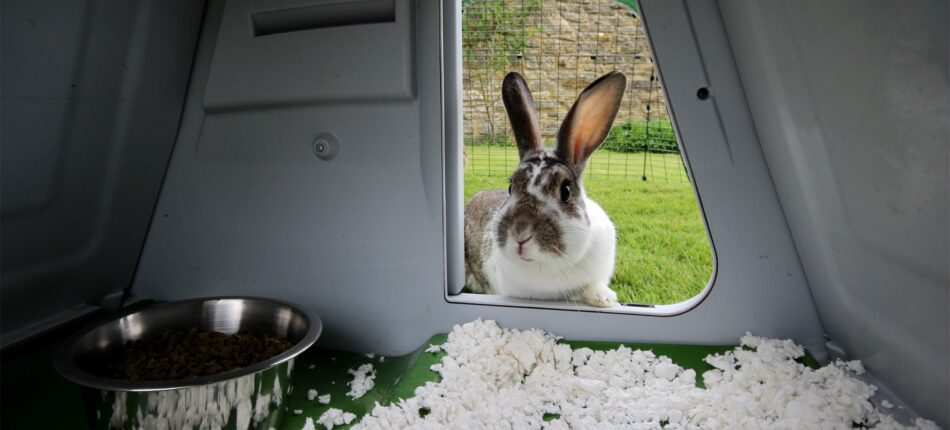
Can my rabbits and guinea pigs live outside year round?
It’s a widely accepted opinion that domesticated rabbits and guinea pigs can’t or shouldn’t be allowed to live outdoors all year round. In actuality, with the right precautions, rabbits and guinea pigs can thrive outside throughout the year. With few exceptions, rabbits and guinea pigs share the same characteristics as their wild counterparts, and are naturally equipped to handle seasonal changes. It’s true that rabbits have cold weather advantages over guinea pigs, as they have larger bodies, fur on their feet, and more dense coats — but cavies can hold their own in cold weather with some tricks up their metaphorical sleeves.
Rabbits and guinea pigs in the wild
It’s important to remember that rabbits and guinea pigs live in the wild without the convenience of central heating or climate controlled conditions. Their coats and natural insulation help keep them warm in the winter. With the exception of Skinny Pigs, most domesticated rabbits and guinea pigs can thrive even in freezing temperatures — just like their cousins in the wild. The secret to success is to get them as close to their natural habitat as possible.
In nature, rabbits dig extensive burrows called warrens. These underground tunnels provide insulation from the elements and create a cozy space to warm up. They’ll huddle together in groups to create more warmth in their own version of climate-controlled homes. And while guinea pigs don’t dig, wild cavies find abandoned burrows or dens dug by other animals to take up residence in. Using the same methods as bunnies, guinea pigs will huddle together for warmth inside of their repurposed burrows.
With these natural behaviors in mind, owners of domesticated rabbits and guinea pigs can simulate this environment for their pets — and in doing so, will equip their bunnies and cavies with the surroundings they need to be supported all year round. If you’re committed to keeping your rabbits and guinea pigs outside throughout the year, you’ll foster their natural behaviors and help them live long, fulfilled lives. So how do you keep bunnies and cavies warm in the winter? It all starts with their hutch.
Hutches are foundational
When people think of rabbit and guinea pig hutches, they often picture wooden houses or even wire cages. But wire cages are clearly intended for indoor use only, and wooden hutches are drafty and rot when exposed to the elements. With traditional options like these, it’s no wonder that rabbits and guinea pigs don’t thrive living outdoors all year round.
In order for bunnies and cavies to get the support they need to live outside full-time, an insulated, weather-proof home is essential. The Eglu Go Rabbit and Guinea Pig Hutch by Omlet offers warmth, shelter, and safety through the winter, and can easily be modified to accommodate fluctuating temperatures. The draft-free design keeps the winter chill off of your pets, while the strategically placed ventilation points prevent moisture from building up. Insulating rabbit and guinea pig hutch covers add an additional layer of protection against sub-zero temperatures, and keep frost and ice from accumulating on the hutch.
By packing the easy-clean droppings tray with straw or hay, you’ll add further insulation to your rabbit and guinea pig’s home. Aim to bed your pets’ hutch down with at least 4-6 inches of good quality straw or hay to give them enough to nestle down in. Adding a rabbit and guinea pig run cover to the attached run will keep their outdoor space free from snow and ice.
Dietary and environmental considerations
Because keeping warm requires more energy, your rabbits and guinea pigs will need quality nutrition throughout the winter to maintain their increased metabolic needs. Eating and digesting stokes their internal heating mechanisms, so providing food high in fiber and protein that takes longer to chew and digest is an excellent way to help your rabbits and guinea pigs stay warmer. Timothy or orchard grass hay, alfalfa cubes or blocks, and fresh seasonal vegetables like sweet potatoes, carrot tops, and leafy greens are all excellent choices. Grass hay should be offered free-choice, and remember to choose pellet feed for your guinea pigs that is fortified with Vitamin C.
Water bottles may freeze when temperatures drop, but bubble wrap or pipe insulation can be wrapped around them to keep them thawed — just be sure to keep this material out of your rabbits’ and guinea pigs’ reach. The ground is also colder during the winter months, so your bunnies and cavies should have a layer of pine pellets, shavings, or straw lining the bottom of their run. This will provide a barrier between their bare feet and the frozen ground.
Zippi Rabbit and Guinea Pig Tunnels are another great way to provide a burrowing experience for your pets, and to get their bodies moving during the cold. These above-ground burrowing pipes simulate tunnels in the wild, and offer an escape from the elements. Zippi Rabbit and Guinea Pig Platforms also get your pets up and moving, and provide a secluded space below for creating cozy cuddle corners.
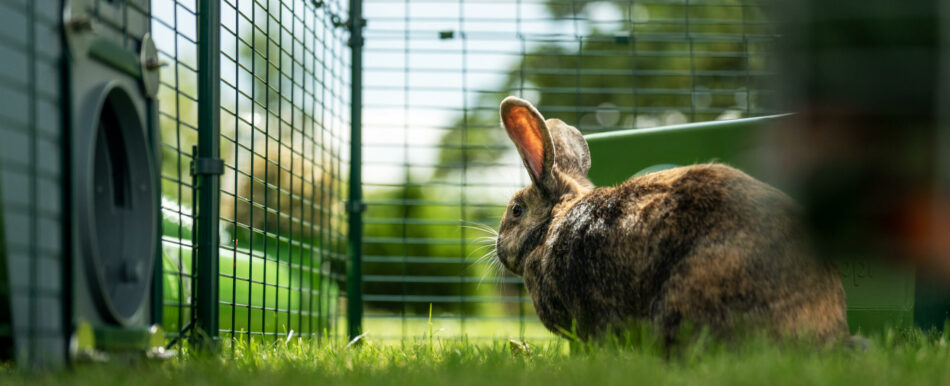
When it’s time to bring them inside
There are no hard and fast rules when it comes to keeping your rabbits and guinea pigs outside all year long. In general, pets that are kept outdoors leading up to winter should be acclimated to the climate. Their coats will have been preparing for the dip in temperature through molting, and their metabolisms will be steadily ramping up for the colder months.
But, there are circumstances where it may not be safe for your rabbits and guinea pigs to stay outside during the winter. These include:
- Rabbits and guinea pigs with certain health conditions, or those that are very young or very old.
- When the temperatures drop into the negatives, or when the wind chill creates sustained sub-zero conditions.
- If your bunnies or cavies haven’t lived outside leading up to the change in seasons.
If you see your rabbits or guinea pigs displaying signs of hypothermia, it’s important to bring them inside right away. Signs of a rabbit or guinea pig getting too cold include:
- Shivering
- Pale feet or ears
- Lethargy
Once you bring your pets inside, they’ll need to remain in a climate controlled environment until moderate weather makes a reappearance. Bringing your rabbits or guinea pigs inside will start to reset their internal temperatures and metabolisms, making it difficult to reacclimate to the colder conditions outdoors. So, once you make the decision to bring your pets inside, remember that it’s not just a temporary visit — it’s for the season.
Omlet and your rabbits and guinea pigs
Keeping your rabbits and guinea pigs outdoors full-time is a personal preference or in some cases, a necessity for certain pets. But with our insulated rabbit and guinea pig hutches, weather protection, and insulating hutch covers, your bunnies and cavies will be equipped to not only withstand the cold, but thrive during the winter.
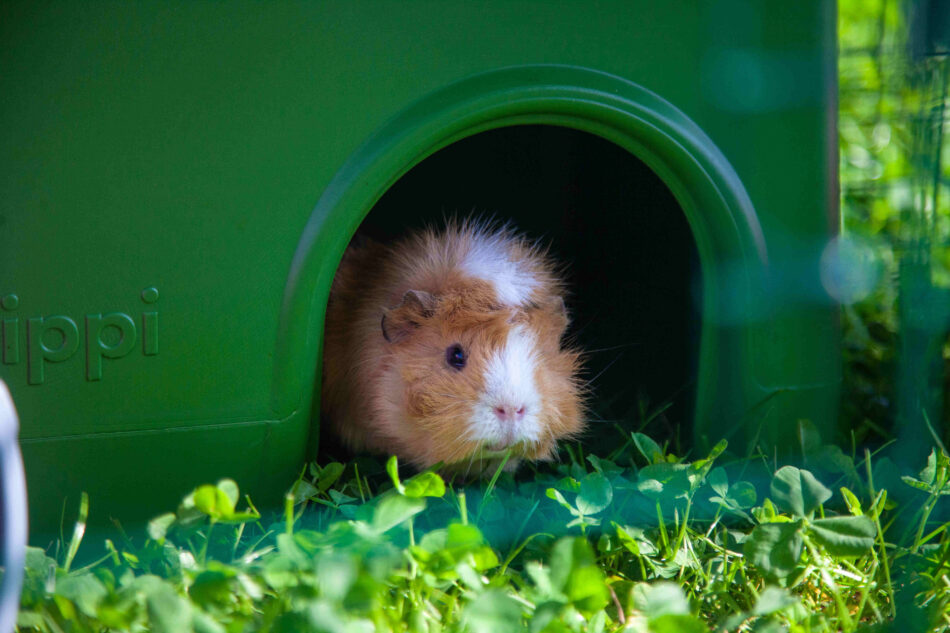

This entry was posted in Guinea Pigs
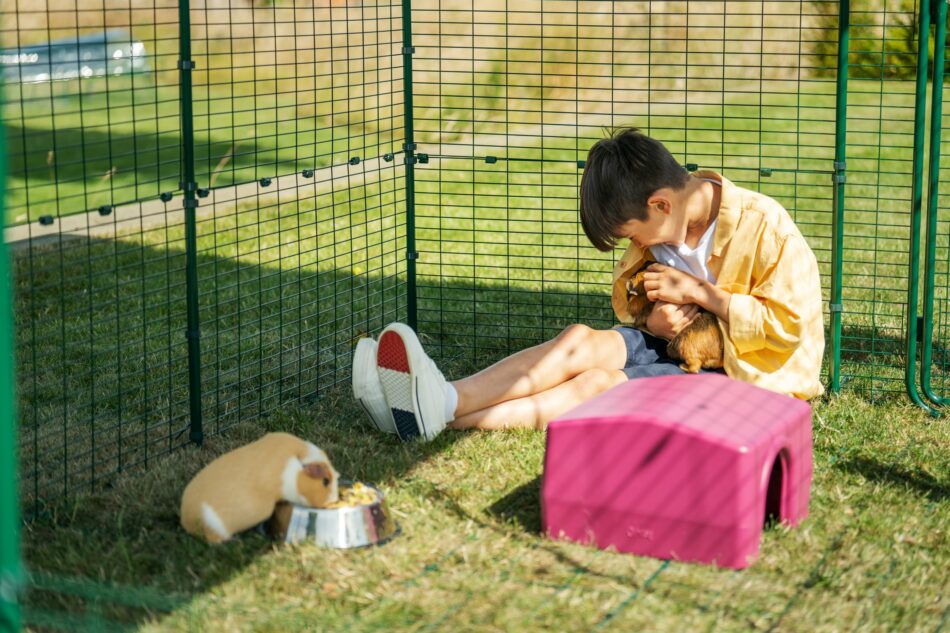
If you’re considering getting a guinea pig, you’re in good company. Guinea pigs (also known as “cavies”) are fun, quirky companions for people of all ages. Though small, these little animals make great pets that are full of character and personality. They’ll happily greet you with a series of adorable noises, affectionately nuzzle you during cuddling sessions, and provide you with hours of entertainment through their various eating and play habits. If you’ve ever owned a guinea pig, you know firsthand how enjoyable and rewarding it can be to have a guinea pig in your family. But, if this is your first time owning a guinea pig, here’s a checklist of everything you need.
A friend for your guinea pig
In the wild, guinea pigs live in groups called “herds”. They’re very social by nature and do best when they have a friend or two. Often guinea pigs will establish bonded pairings, but sometimes a group of 3 can be inseparable. A lone guinea pig will become depressed quickly, so be sure to plan on keeping at least 2 guinea pigs from the start.
Same-sex siblings are often a desirable pairing. Other same-sex pairings may also be successful, but you’ll want to introduce them slowly before housing them together. Be sure to only keep neutered males with females — otherwise, you’ll end up with accidental guinea pig pups. The idea of baby guinea pigs may sound cute, but behind the cuteness is a lot of extra care and having to separate males from females when they’re old enough to be weaned. And, unless you’ve got a lot of space or multiple setups, you’ll also need to find homes for the pups.
A cozy cavy hutch
Your guinea pigs will need a hutch to live in, even if you intend to keep them in your home. Whether you opt for a modern hutch like our Eglu Go guinea pig hutch or an indoor hutch option, you’ll need to weigh your decision carefully.
A good hutch is vital to a guinea pigs’ wellbeing. It’s their home, and where they’ll spend the majority of their time. Well-made hutches provide a secure environment for your guinea pigs to sleep, socialize, and exercise, and it will last you and your pets many years. And, by investing in a high-quality hutch, you won’t have to worry about maintenance or replacements.
The Eglu Go hutch can comfortably house 2-3 guinea pigs, and is the easiest cavy home you’ll ever have the pleasure of cleaning. Our unique design encourages your guinea pigs to express their natural behaviors, making them feel right at home from the beginning. And, with twin-insulated walls, your cavy will stay comfortable in any season.
It’s a common misconception that guinea pigs can’t be housed outdoors year-round. When they’re provided with quality shelter and space, they adapt well in natural settings. Special care should be taken during extreme weather conditions and temperatures, but guinea pigs can live outdoors safely the majority of the year in a setup like the Eglu Go guinea pig hutch.
It’s important to note that guinea pigs should be brought inside when temperatures are consistently above 80 degrees or below 50 degrees. Unless you’re able to check on them every couple of hours during temperature dips or spikes, it’s best to bring them in a temperature-controlled environment.
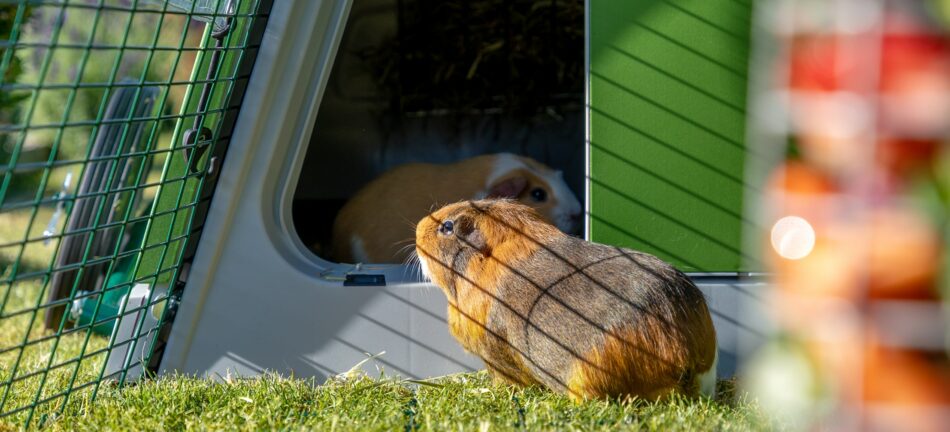
Space to exercise and play
Like most pets, guinea pigs thrive when they have as much space as possible. It’s especially important for guinea pigs to have room to exercise, as they are prone to obesity. Their little legs are adorable, but struggle under extra weight. The attached run of the Eglu Go guinea pig hutch offers your cavy room to run and play, but you can give them even more space by adding Zippi Guinea Pig Runs and Playpens.
The Zippi Guinea Pig Tunnel System brings all of this together by creating a route between their hutch and playpen. In the wild, guinea pigs seek shelter in burrows or tunnels constructed by other animals. They’re constantly on the lookout for potential threats, so providing hideouts and tunnels appeals to their desire to seek shelter. And, with convenient attachment kits, the Zippi guinea pig tunnel system can be connected to wooden hutches or any wire run easily.
For additional exercise, Zippi Guinea Pig Platforms can be installed inside of our playpens. The ramp is specially designed for little cavy legs, and the safety rails help prevent accidental tumbles. Zippi platforms are a great way to utilize aerial space, and to help you interact with your guinea pig on a whole new level — literally.
A quality diet and fresh water
Guinea pigs should have free-choice access to quality pellets and fresh water at all times. Their feed should consist of timothy hay-based pellets, rather than the “trail mix” variety of food. When offered this mix, cavies will pick out their favorite bits and leave the more nutritious pieces behind. Since guinea pigs can become overweight easily, it’s important to only feed them foods that offer nutritional value and not empty calories.
Cavies are in the rodent family, and as such, their teeth continuously grow. To combat this, make sure they have access to loose timothy hay at all times. In the wild, guinea pigs graze on grasses and plants all day long to help keep their teeth trimmed and their bellies in working order. In addition to their hay, offer your guinea pigs fresh herbs, leafy greens, and guinea pig-safe vegetables in moderation to round out their diet. As an occasional treat, you can serve your guinea pigs small pieces of fresh fruit.
Vitamin C
Guinea pigs are among a small group of mammals that can’t make their own vitamin C. Like humans, they need their daily dose of this essential vitamin in order to stay healthy. Most commercially made guinea pig pellets have vitamin C added, but be sure to check labels.
There are multiple other ways to make sure your guinea pigs are getting enough vitamin C. These include:
- Store-bought vitamin C drops to add to their water
- Offer vitamin C-rich veggies like broccoli, bell pepper, or dark leafy greens
- During playtime, reward your cavy with vitamin C-rich fruits like strawberries
A predictable routine
Guinea pigs will find comfort in their daily routine and soon come to expect their meals, playtime, and bedtime. They’ll also quickly learn that you are the bringer of food, playtime coordinator, and provider of safety — and will reward you with friendly squeaks and other noises from guinea pig vernacular.
Plan to check in on your guinea pigs at least once a day, but the more you interact with themes, the better your bond will be. Your cavies will soon anticipate your visits and will be more active when you spend time with them.
Omlet has all your guinea pig needs
We’ve designed comfortable cavy homes that keep your guinea pigs safe while making caring for them easier than ever for you. Our Eglu Go guinea pig hutch, Zippi Guinea Pig Tunnel System, and Zippi Guinea Pig Runs and Playpens are instant housing and enrichment solutions for cavy keepers of all ages and experience levels. With Omlet, you’ll be able to start keeping guinea pigs with success from the beginning.
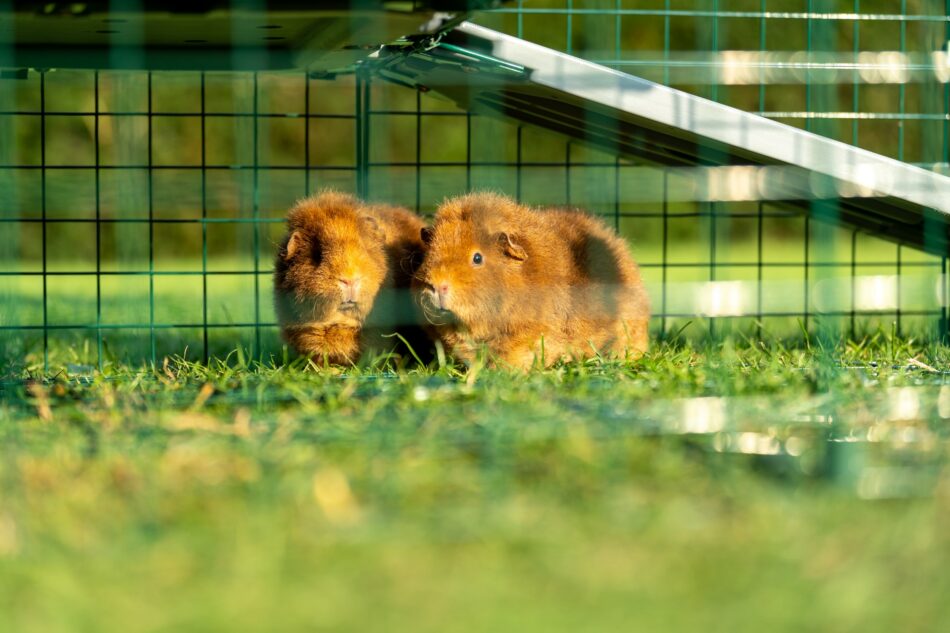

This entry was posted in Guinea Pigs
Wondering how to give your rabbits and guinea pigs more space? These small pets need more space than most people realize, and thrive best in an outdoor environment. In order to see those coveted “boings” and “popcorns” that rabbits and guinea pigs display, they’ll need ample space across grass or another non-slip surface. If you’re not seeing these outward displays of joy, it may be time to give them more room. Discover the best setups to provide space and safety for your small pets, and how this added area benefits both their minds and bodies.
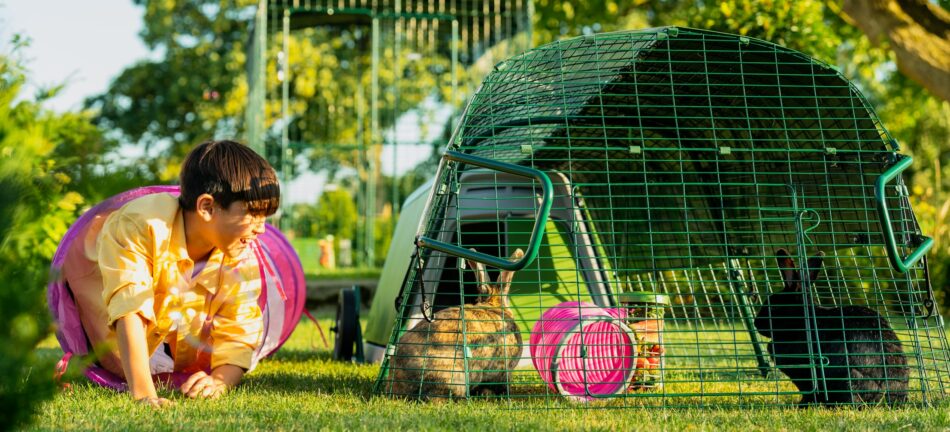
HOW MUCH SPACE SHOULD MY RABBIT OR GUINEA PIG HAVE?
You probably aren’t going to take your rabbit for a run every day, or make sure that your guinea pigs are getting their paces in. So to ensure they’re getting enough exercise, rabbits and guinea pigs need as much space as possible. But how much is enough? There’s no exact formula, but traditional hutches just don’t cut it.
Rabbits and guinea pigs should have an insulated outdoor hutch with a fully enclosed run. This gives them a safe place to sleep and shields them from inclement weather, while also giving them ample space to nibble on grass and benefit from the fresh air. Our Eglu Go Rabbit and Guinea Pig Hutches are designed with twin-wall insulation, and feature strong wire-weld mesh runs complete with anti-dig skirting to prevent predators from digging into their run. Our rabbit runs also come standard with a wire underfloor to keep bunnies from burrowing out.
HOW CAN I ADD MORE SPACE FOR MY RABBIT OR GUINEA PIG?
With these active animals, more space is always better. Adding space with Zippi Runs and Playpens for Rabbits and Guinea Pigs allows you to create multiple areas for different types of enrichment. The same heavy-duty wire that is used for our attached runs make our Zippi Run and Playpens a safe, secure, and resilient place for your small pets to experience the outside world.
Choose from a variety of options to fit both your pet and space. For rabbits, our double-height playpens and runs are the perfect size to keep boisterous bunnies contained, and have underfloor mesh to keep burrowing to a minimum. Cavies can safely enjoy our single-height runs and playpens, with or without underfloor mesh. Both our single and double heights have the option to add roof panels and anti-dig skirting around the outside for even more security.
Double the fun that our double-height runs have to offer when you add Zippi Platforms for Rabbits and Guinea Pigs. Utilize aerial space in their run, and give your pet a platform to perform tricks, meet for mealtime, or see you at eye level. Bunnies and cavies alike will feel the benefits of “taking the stairs” when they use the non-slip ramps to access our Zippi platforms. After all that exercising, the space below the Zippi platform offers a shady spot to take a post-workout nap.
CONNECT THEIR SPACES WITH A TUNNELING SYSTEM
Why stop at playpens and runs? We also invented the ultimate tunneling system for both rabbits and guinea pigs to fulfill their natural desires to burrow. Our one-of-a-kind Zippi Tunnel System for Rabbits and Guinea Pigs can act as a standalone track set up for playtime, or be connected to any run or hutch. Design routes for your rabbits or guinea pigs to go from their hutch to their playpen or run and watch them enjoy being in their element.
Our Zippi tunnels are made of durable materials that are meant to last, and can be customized with our intuitive Zippi Tunnel Builder. Create twists, turns, look-out hay feeders, intersections and more when you design your own course. And keep your rabbit or guinea pig on their toes by adding onto or reconfiguring the Zippi Tunnel System at any time.
OTHER ENRICHING ACTIVITIES FOR RABBITS AND GUINEA PIGS
Zippi Runs and Playpens also give you an opportunity to add even more engaging activities to your pets’ space. Create a treat-filled maze for your cavy out of repurposed cardboard boxes, or make a digging box for your rabbits with a litter pan or cardboard box filled with treats and shredded paper. Add bunny or cavy shelters to your pets’ home to incorporate even more places to explore within their enclosure.
Along with exercise, diet is important to keep your rabbits or guinea pigs in optimum health. Offering treats occasionally is fine, but the bulk of their diet should be timothy hay-based pellets and free-choice timothy hay. You can also offer fresh greens in our Caddi Rabbit and Guinea Pig Treat Holder to attach to their run. This elevated treat dispenser reduces waste and encourages your pets to stretch their bodies and mind to reach their treats.
OMLET AND YOUR SMALL PETS
At Omlet, our goal is always to bring people and pets closer together. Our entire line of rabbit and guinea pig products are designed to foster natural behaviors in these small pets, while bringing enjoyment and wonder to their owners. Zippi Rabbit and Guinea Pig Platforms, the Zippi Rabbit and Guinea Pig Tunnel System and Zippi Outdoor Rabbit and Guinea Pig Runs are all creative accessories that let you and your pets experience their world like never before. You’ll be amazed by how happy and at ease rabbits and guinea pigs are when they’re in an environment that they truly enjoy.
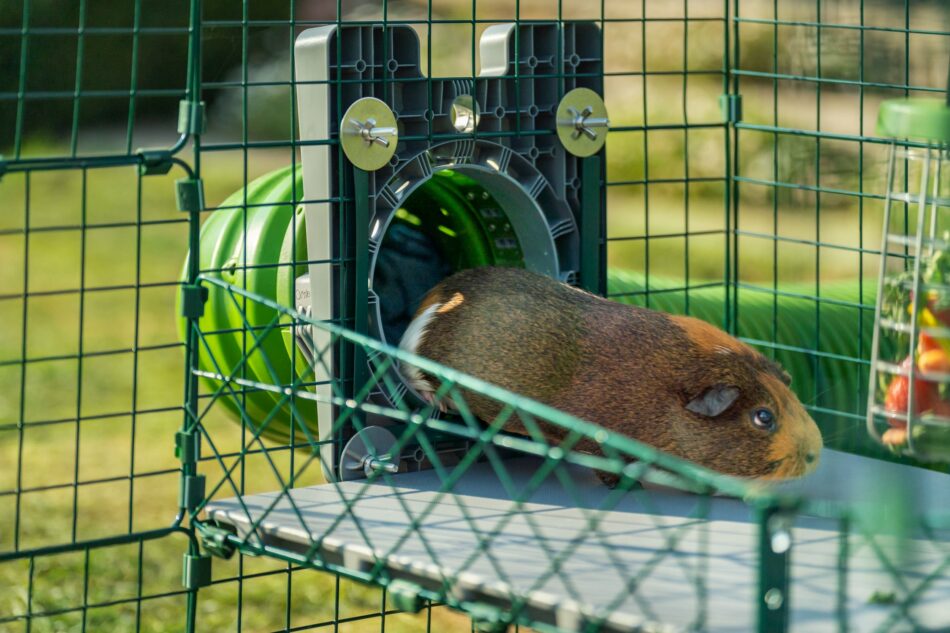

This entry was posted in Guinea Pigs
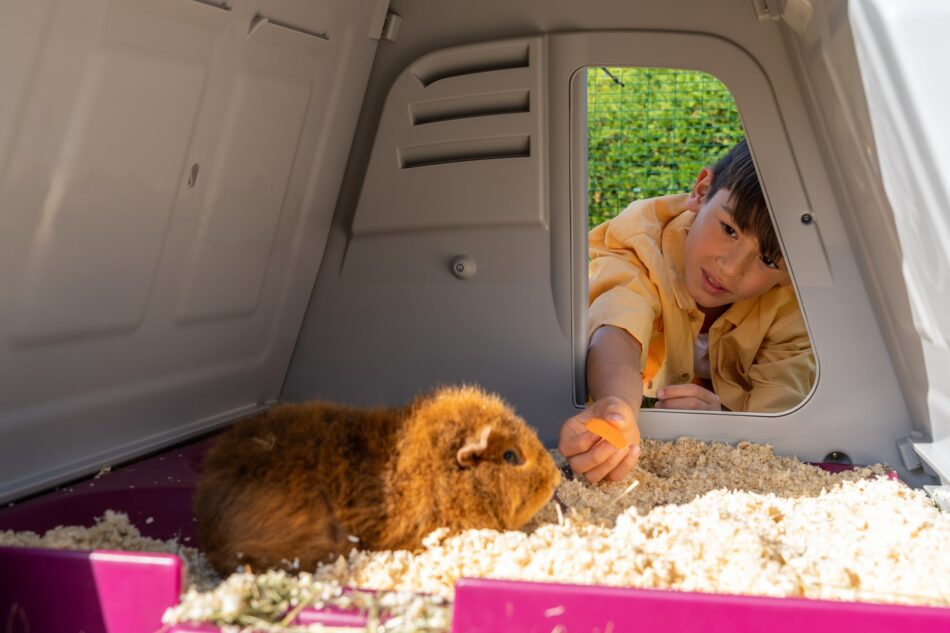
Guinea pigs are amazing, social pets that have lots to offer the families that share a home with them. But do you know how they got their name, how much (or little) they sleep, and how many toes they have? These 12 facts you might not know about your guinea pig will increase your love and appreciation for your cavies.
1. What’s in a name?
“Guinea pig” is actually a misnomer. They aren’t from Papua New Guinea — rather, they originate from the Andes mountains of Peru. The first part of their name is due to them being sold for a guinea (an old English coin) when sailors brought them from South America.
2. Not pigs at all
The second half of a guinea pig’s name is also a misnomer. They aren’t related to pigs at all — they’re actually members of the rodent family. Guinea pigs are so named because of the grunting noises they make, which reminded people of piglets. The other term for guinea pigs is “cavies”, or singular, “cavy.” It comes from their scientific name Cavia porcellus, with porcellus meaning “little pig.”
3. Even more misnomers
Like pigs, male guinea pigs are called boars and females are called sows. But, instead of baby guinea pigs following suit and being called piglets, they’re called pups. Even though their names imply they are similar to puppies at birth, this too, is incorrect. In reality, canine puppies and guinea pig pups have very little in common at birth.
4. Born ready
“Pups” are born with fur and their eyes open, and are very mobile from an early age. Most other species of rodents are born hairless and blind, unable to venture beyond their nest during the first few days of life. Guinea pig pups can see, walk, hear, and even have teeth. This gives them an advantage as prey animals in the wild.
5. Size and stature
Fully grown guinea pigs weigh between 1 and 3 pounds and are 8 to 16 inches long. Boars tend to be larger than sows, but should not be overweight. Guinea pigs are prone to obesity, which may be difficult to detect due to their oblong, potato-like shape. Cavies are considered overweight if you can’t feel their spine, ribs, or hips through their fat, or if they develop visible fat pads.
6. A longer lifespan than other rodents
Small pets aren’t known for their long lifespans, but guinea pigs actually live a relatively long life when they’re well cared for. The average lifespan of a domesticated guinea pig is 5-7 years.

7. Abnormal number of digits
Guinea pigs have 4 toes on their front feet, but only 3 on their back feet. This brings their total toe count to 14. But, some guinea pigs may have more than the expected number of toes if they have a condition called “polydactyly” which is a genetic mutation that causes extra toes to grow.
8. Ever-growing teeth
Like other rodents, cavy teeth grow continuously throughout their lives. It’s important to give them food and treats to gnaw on to help them keep their teeth in check. Serving your guinea pigs’ favorite chews in a Caddi guinea pig treat holder will help keep their teeth-trimming treats at an accessible level.
9. Surprisingly little sleep
Guinea pigs don’t sleep much. In fact, they only sleep about 4-6 hours in a 24-hour period. They’re also proficient in power napping — taking short naps lasting anywhere from a few seconds to a few minutes, but usually not more than 30 minutes at a time. Cavies need a comfortable guinea pig hutch to get optimum rest during these short slumbers.
10. Very vocal
Guinea pigs have their own language, and are extremely vocal. Their broad range of noises include: purring, whining, shrieking, cooing, rumbling, hissing and teeth chattering. It’s very common for guinea pigs to greet their owners in what cavy keepers have dubbed a “wheek” — a happy, excited noise that a guinea pig emits.
11. Cavy companions
Guinea pigs are very social animals and need companionship to thrive. Their vast vocabulary and social relationships are best shared with other cavies. Bonded pairs are usually the happiest, but some guinea pigs will happily live in a social group of 3 or more. Remember to only keep same-gendered or spayed and neutered pairs together to avoid accidental litters.
12. A coat for every occasion
Guinea pigs come in a variety of colors and textures. Their different breeds create long and short coats with textures ranging from curly and wavy, to short and smooth, to no hair at all.
Owning guinea pigs with Omlet
Cavies are cute, quirky pets that the whole family can enjoy. By housing them in secure outdoor guinea pig hutches, you’ll be able to observe all of the wonderful attributes that your cavies display. Elevate their favorite foods and watch them exhibit these natural behaviors, while observing the unique attributes that make guinea pigs some of the most entertaining and enjoyable pets to share your space with.
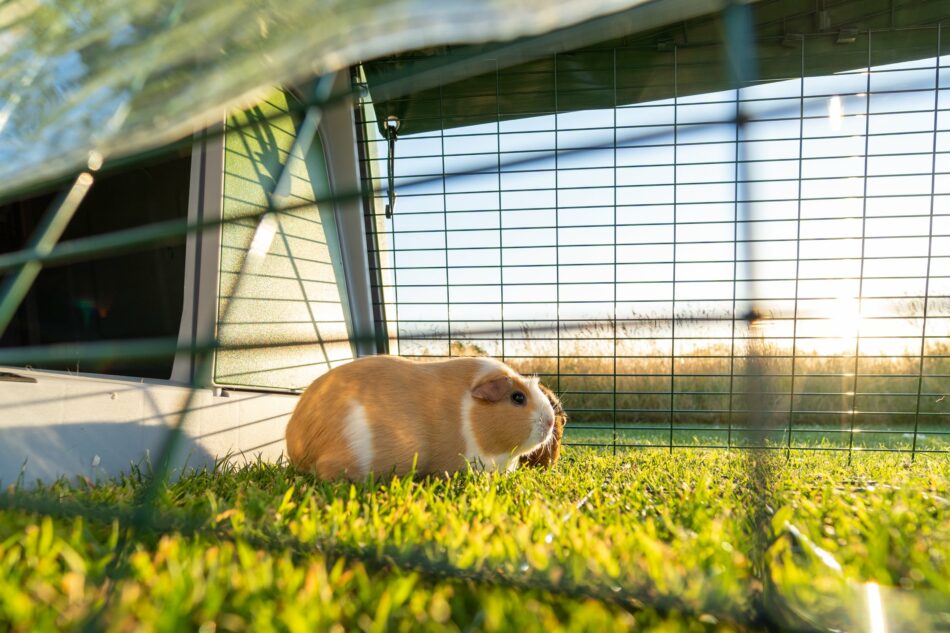
This entry was posted in Guinea Pigs



 What is popcorning in guinea pigs?
What is popcorning in guinea pigs?

























